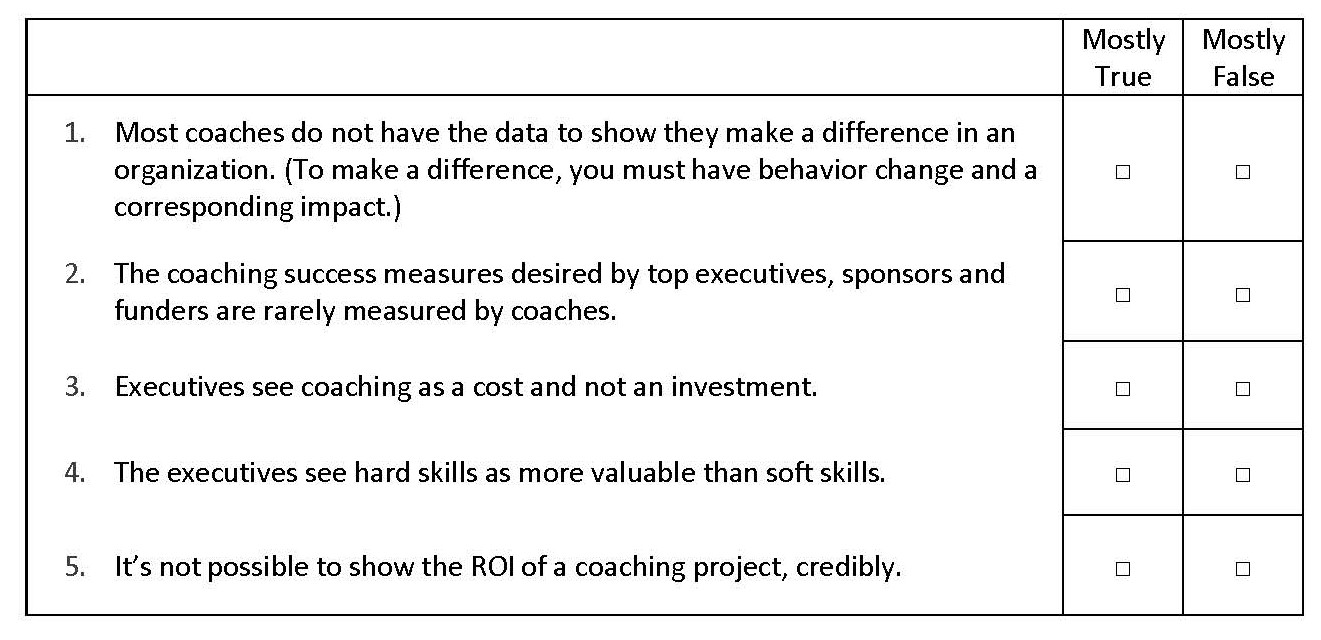Your cart is currently empty!
Does Coaching Deliver Impact?
by Patti P. Phillips, Ph.D., and Jack J. Phillips, Ph.D.
This article was originally published on October 29, 2021, on ChiefLearningOfficer.com.
Take this Quiz
For each of these statements, indicate either mostly true or mostly false based on your experience with coaching. Be candid with your responses.

We’ve conducted this poll several times, usually before webinars or conference presentations. The majority of the coaches indicate mostly true on all five of these questions. Obviously, the responses should be mostly false. If you don’t have data to show that you make a difference, that puts your coaching at risk. Ignoring the measures desired by executives is not a safe strategy in this uncertain and competitive environment.
If executives see coaching as a cost and not an investment, we know what happens. Programs are paused, frozen, delayed, reduced or even eliminated. Most coaching is considered a soft skill. When executives perceive hard skills as more valuable than soft skills, coaching has a disadvantage from the beginning. And finally, it is possible to show the value of coaching at the impact and ROI levels. Hundreds have done this, and it’s not that difficult. This article will address these challenges and show how this is being done.
Challenges
The challenge is for the industry to show the value of coaching in terms that donors, funders and supporters clearly understand. This usually means evaluating coaching programs to the impact and ROI levels. However, many coaches are reluctant to evaluate coaching to those levels, thereby failing to connect what they do to business measures.
Taking a few straightforward steps can ensure coaching delivers value and eliminates the probability of a negative ROI. A process is needed that has the capability of designing coaching to deliver business value and measure that value credibly, using conservative methods and assumptions. The ROI Methodology is the appropriate evaluation system to do this.
New Normal Opportunities
Organizations are facing tough, competitive environments. The global recession caused by the COVID-19 pandemic is creating more pressure on organizations of all types to be more effective and efficient. The challenge for providers of services, such as coaching, is to ensure those services can meet these five realities.
- Budgets will be tight and obtaining approval is going to be more difficult than in the past.
- A “show me the money” mentality is ever-present.
- In some cases, ROI forecasting might be the only way to get approval for the coaching budget.
- In a competitive environment, coaching results should stand out from others.
- Finally, there is a need to validate the value proposition for coaching.
These are great opportunities for coaches to step up and show the impact and ROI of a major coaching project. This allows coaches to stand out from the competition.
The Concerns about Coaching
Along with the popularity of coaching is the concern about the value of coaching. Three issues bring this into focus:
Impact is missing. The 2020 Global Coaching Study conducted by the International Coaching Federation revealed that coaching is growing, with nearly $3 billion in revenue globally. However, there are some challenges with coaching. Survey respondents were asked what they perceived to be the top three obstacles to building a strong coaching culture in an organization. The three top obstacles were:
- Limited support from senior executives (50 percent).
- Inability to measure the impact of coaching (42 percent).
- The lack of budget for coaching activities (38 percent).
There was a considerable consensus across all main demographics on these top obstacles. These obstacles could be removed if executives had proof that coaching drives business value.
Considering these data points were collected in 2019, before the pandemic, the situation is even more difficult as executives are trimming and, in some cases, eliminating coaching budgets because they don’t see the connection of coaching to the business of the organization.
Behavior is the principal focus. Behavior change has been the basis of coaching success for many years. While behavior is important, it’s the consequences of using the new behaviors that make the difference. That’s the impact, and the two go together. Behavior without a consequence is just being busy. Executives understand this, so they want to see the impact of coaching. Yet, many organizations continue to focus on behavior. For example, a recent 100-page report from The Institute of Coaching, “Leading with Humanity: The Future of Leadership and Coaching,” focuses on the success of coaching but only from a behavior perspective. There is no mention of the impact of coaching. Yet, we all know executives would like to see tangible, measurable impacts from coaching.
Alignment and focus are incomplete. Too often, coaching engagements are based on behavior. The coach identifies the particular skills, behavior changes or actions needed and coaches the client to bring about the change. When this is the case, the illusion of final success is that the behavior change has occurred. Behavior is a success level but not the one desired by many and not the one that really shows the business value of the coaching.
To do so means the engagement has to start with impact or at least quickly migrate to impact. The particular impact measures in the KPIs of the client must be clearly identified. Then, together, the coach and the client will decide if they can improve that measure working together as a team. When this is done, two important things have occurred. Coaching is connected to the business, and the team has validated that coaching is the right solution.
The next step is to make sure there is proper focus. The focus comes from setting objectives for the coaching, starting with the impact objective that’s been identified previously. Then, having application or behavior objectives and learning objectives (identifying what the person being coached will learn from the coach or learn about themselves through the coach’s effort). Finally, reaction objectives are developed, indicating how the person being coached should react to the process. These multiple levels of objectives provide the focus necessary to achieve the needed business impact.
The ROI Methodology
How does this work? The ROI Methodology is the best approach to tackle this issue. Here’s a brief summary.
Evaluation Framework
Coaching results are reported in the context of the five-level ROI framework. This framework is used to categorize results for all types of programs and projects, including coaching.
- Level 1 Reaction — data representing client reactions to coaching and their planned actions are collected and analyzed. While reaction may include client views of the coaching format, duration, coach effectiveness and fit, they must also include measures of utility such as relevance, importance, amount of new information, client’s intent to use the coach to make changes and willingness to recommend the coach or coaching program to others.
- Level 2 Learning — data representing the acquisition of knowledge about their strengths, development areas, and skills are collected and analyzed. This category of data also includes the level of confidence to use what the client is learning.
- Level 3 Application and Implementation — data are collected and analyzed to determine the extent to which clients apply their knowledge and skills. This category of data also includes data that describe the barriers that prevent application as well as any supporting elements (enablers) to application.
- Level 4 Business Impact — data are collected and analyzed to determine the extent to which coaching has positively influenced key measures that were expected to improve as a result of the coaching experience. When reporting data at Level 4, a step to isolate the program’s effects on these measures from other influences is always taken.
- Level 5 Return on Investment — impact measures are converted to monetary values and compared to the fully loaded program costs.
Evaluation levels provide a clear and understandable framework to manage the coaching program’s design and objectives, as well as the data collection process. Also, these five levels present data in a way that makes it easy for executives and sponsors to see results of the coaching program. When reported together, the five-level ROI framework represents data and a story of program success or challenges.
The ROI Model
The chain of impact is the framework for the ROI Methodology presented in Figure 1. The first three steps of the model are the alignment and focus issues discussed earlier. As coaching is connected to the business, the right solution is validated, and success is expected. The next two steps involve collecting data around the first four levels of the framework presented above. The next five steps are all around the analysis as the effects of coaching are isolated from other influences, impact measures are converted to money, intangibles are identified, costs are tabulated and ROI is calculated. When this is done, the results tell a great story using numbers and narratives. This data is then used in the last step of the model to improve the coaching process and make the case for continuing funding.
Figure 1. The ROI Methodology
This capability has been and can be developed with coaches. The ROI Methodology is user-friendly, credible, reliable and CEO and CFO friendly. It’s guided by Twelve Guiding Principles to make sure that the data collection, analysis, and reporting is credible and conservative.
ROI Methodology Use
The methodology has been adopted by three-fourths of the Fortune 500 organizations and major organizations worldwide, including The United Nations, which adopted this methodology as the evaluation system of choice with a UN General Assembly Resolution in 2008. The process has been adopted by 26 federal governments, more than 300 health care associations, 150 universities and many nonprofits, charities and faith-based organizations. It has now become the most-used evaluation system in the world with more than 6,000 organizations systematically and routinely using it. The methodology has been endorsed and used by the coaching profession for over a decade. It was highlighted in the book, “Measuring the Success of Coaching: A Step-by-Step Guide for Measuring Impact and Calculating ROI” (ASTD, 2012) by Patti P. Phillips and Jack J. Phillips.
Action is Needed
Coaches need results showing the impact and ROI of a major coaching project. This evaluation must use a process that can drive business value and measure the success credibly so that top executives, and even the CFO, clearly understand and support the results.
So, there you have it — a system to deliver results from coaching reflecting impact and ROI. Showing the value of coaching is possible; it’s being done, and it makes a world of difference in terms of acceptance, support, funding and respect for coaching. Coaching is a powerful tool and has evolved into a mainstream activity. We have to make sure that it continues to thrive in organizations. We can only do that by showing that it delivers value to the organizations.


























